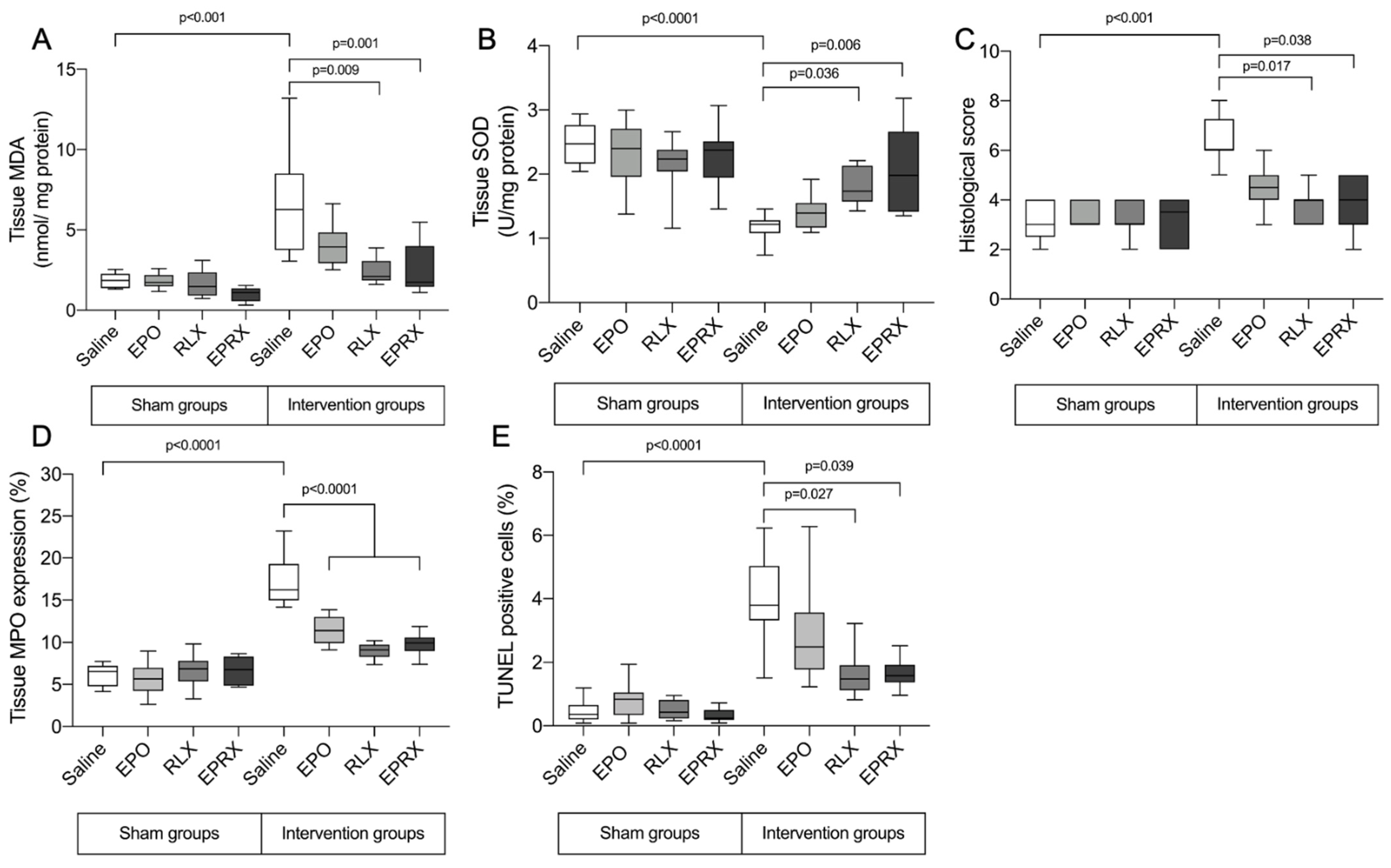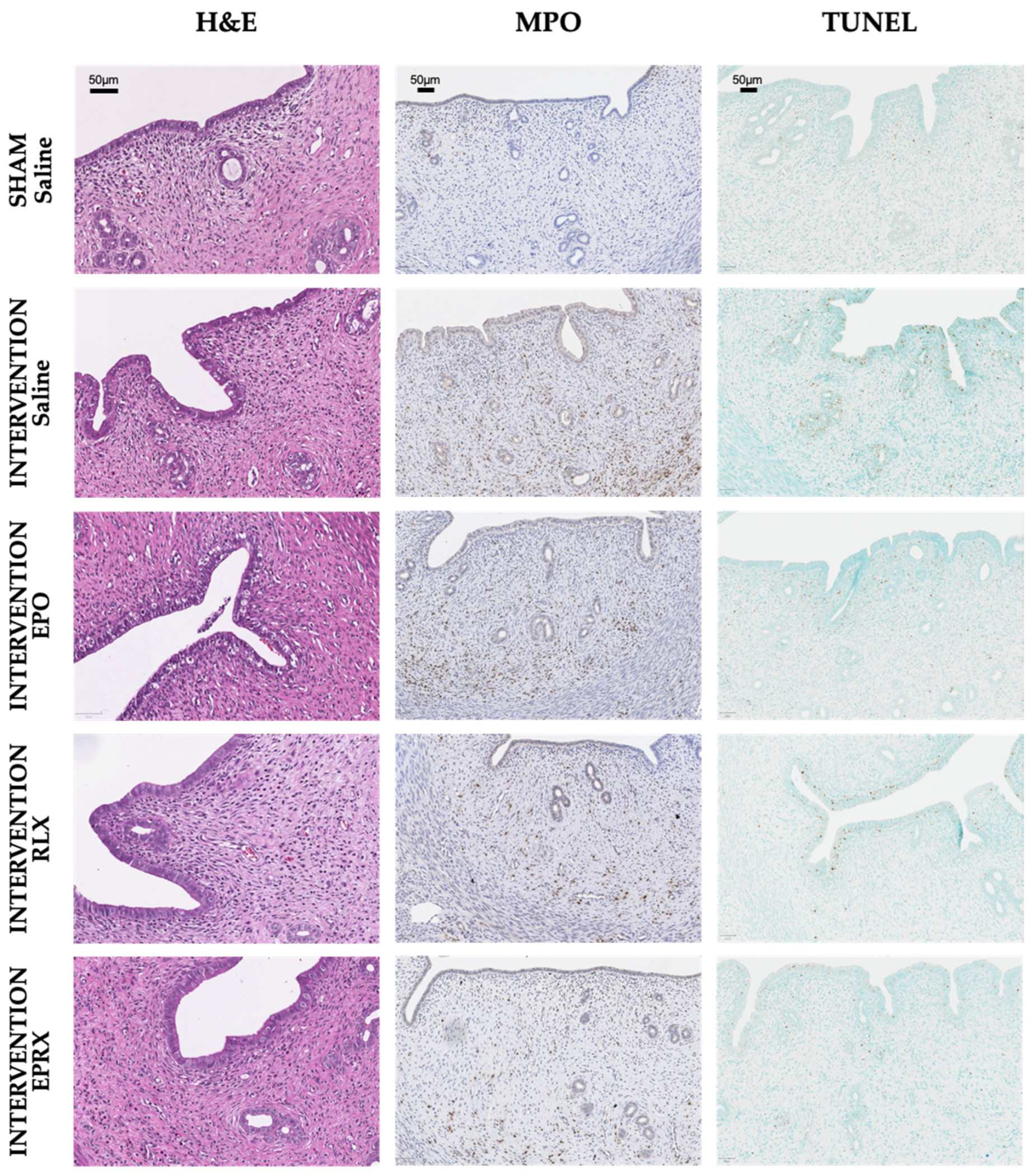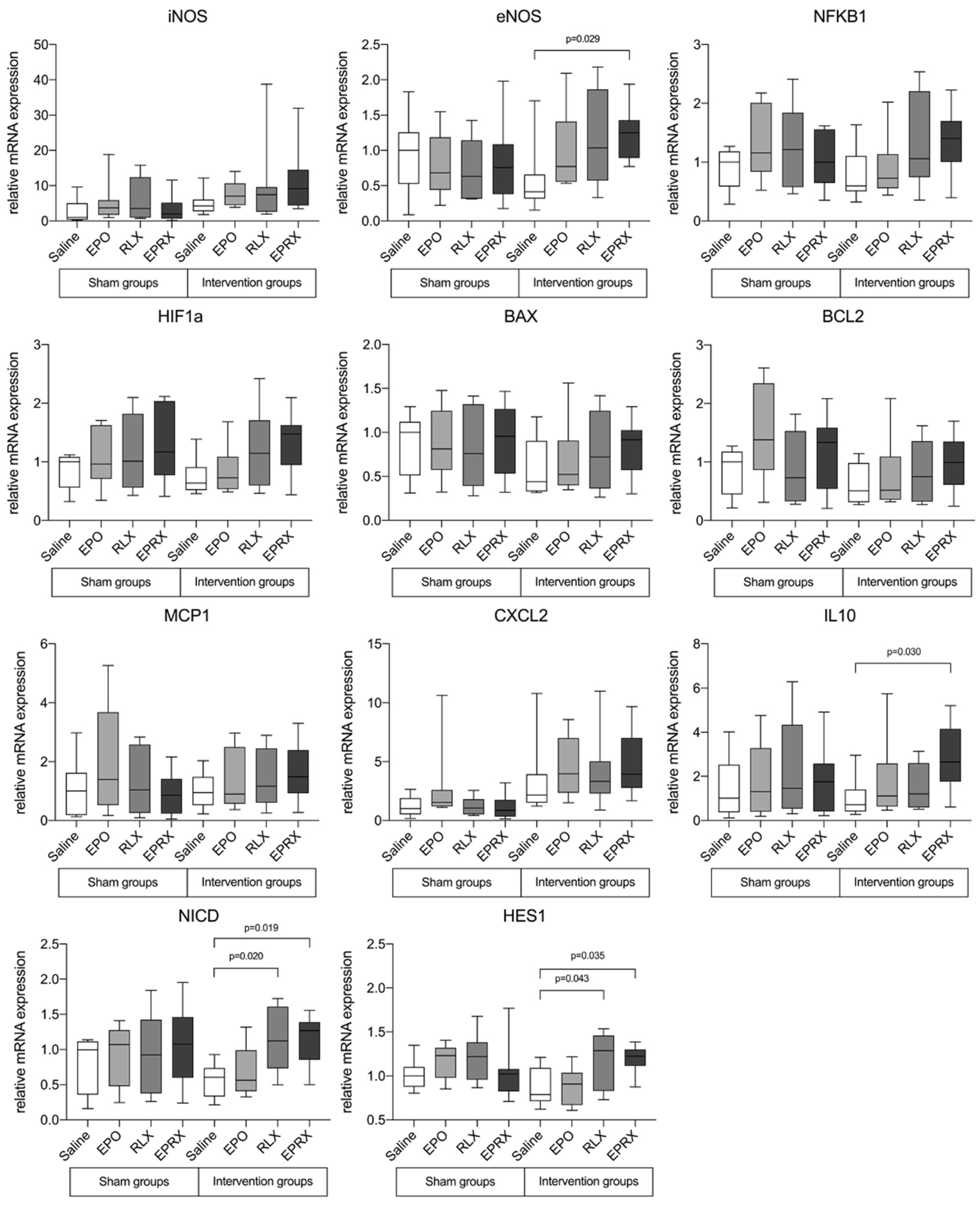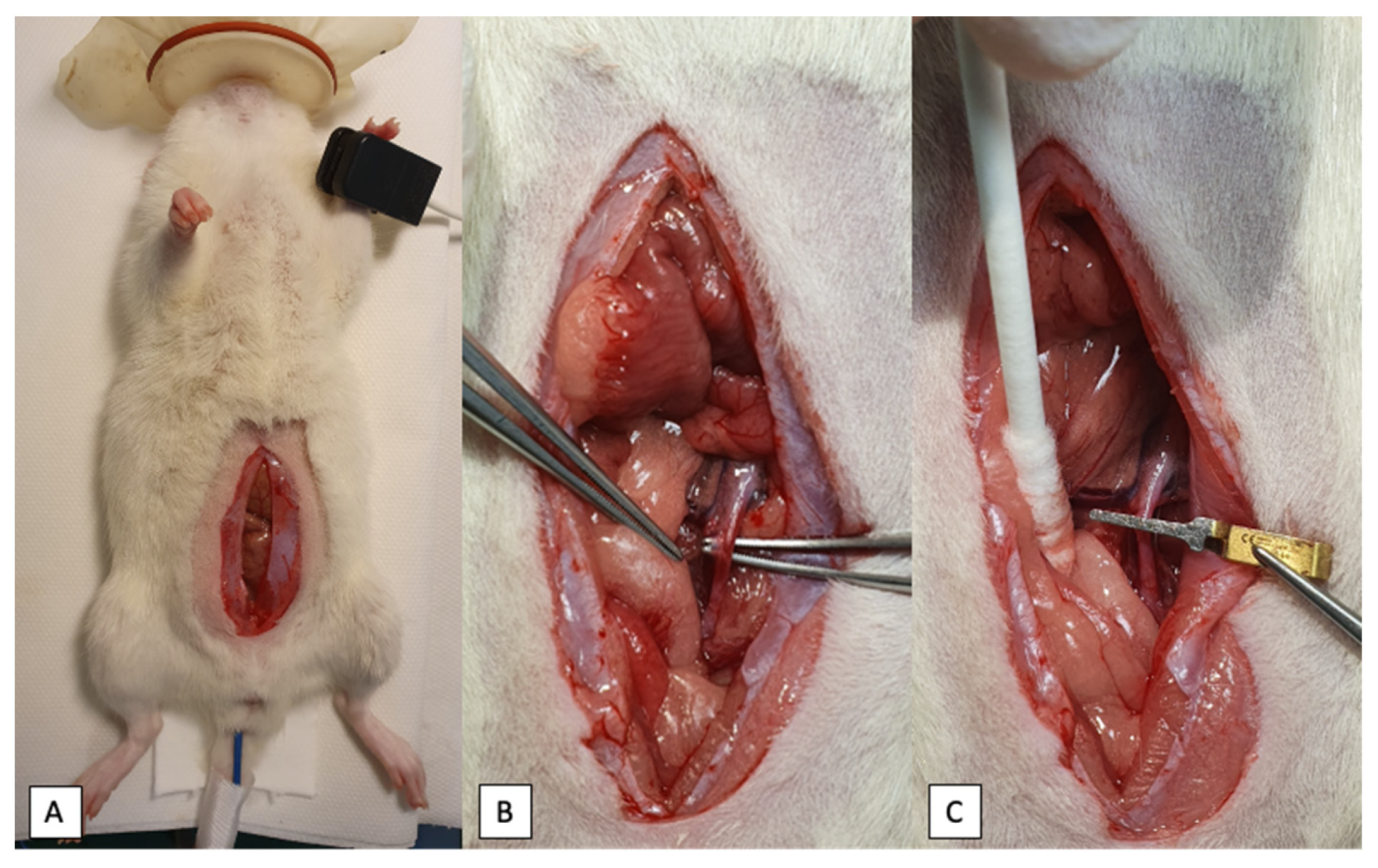Relaxin and Erythropoietin Significantly Reduce Uterine Tissue Damage during Experimental Ischemia–Reperfusion Injury
Abstract
1. Introduction
2. Results
2.1. Tissue Biochemical Analysis
2.2. Morphology, Neutrophil Infiltration and TUNEL Assay
2.3. Gene Expression after Ischemia–Reperfusion Injury
3. Discussion
4. Materials and Methods
4.1. Animals
4.2. Experimental Design
4.3. Tissue Morphological Evaluation
4.4. Biochemical Analysis
4.5. Immunohistochemical (IHC) Staining
4.6. TUNEL Assay
4.7. Real-Time qPCR
4.8. Statistical Analysis
5. Conclusions
Author Contributions
Funding
Institutional Review Board Statement
Informed Consent Statement
Data Availability Statement
Conflicts of Interest
References
- Brännström, M. Uterus transplantation. Curr. Opin. Organ Transplant. 2015, 20, 621–628. [Google Scholar] [CrossRef] [PubMed]
- Brännström, M.; Johannesson, L.; Dahm-Kähler, P.; Enskog, A.; Mölne, J.; Kvarnström, N.; Diaz-Garcia, C.; Hanafy, A.; Lundmark, C.; Marcickiewicz, J.; et al. First clinical uterus transplantation trial: A six-month report. Fertil. Steril. 2014, 101, 1228–1236. [Google Scholar] [CrossRef] [PubMed]
- Bagnoli, V.R. Conduta frente às malformações genitais uterinas: Revisão baseada em evidências. Femina 2010, 38, 217–228. [Google Scholar]
- Jones, B.P.; Williams, N.; Saso, S.; Thum, M.; Quiroga, I.; Yazbek, J.; Wilkinson, S.; Ghaem-Maghami, S.; Thomas, P.; Smith, J.R. Uterine transplantation in transgender women. BJOG Int. J. Obstet. Gynaecol. 2018, 126, 152–156. [Google Scholar] [CrossRef]
- Brännström, M.; Belfort, M.A.; Ayoubi, J.M. Uterus transplantation worldwide: Clinical activities and outcomes. Curr. Opin. Organ Transplant. 2021, 26, 616–626. [Google Scholar] [CrossRef] [PubMed]
- Ejzenberg, D.; Andraus, W.; Mendes, L.R.B.C.; Ducatti, L.; Song, A.; Tanigawa, R.; Rocha-Santos, V.; Arantes, R.M.; Soares, J.M., Jr.; Serafini, P.C.; et al. Livebirth after uterus transplantation from a deceased donor in a recipient with uterine infertility. Lancet 2018, 392, 2697–2704. [Google Scholar] [CrossRef]
- Flyckt, R.; Falcone, T.; Quintini, C.; Perni, U.; Eghtesad, B.; Richards, E.G.; Farrell, R.M.; Hashimoto, K.; Miller, C.; Ricci, S.; et al. First birth from a deceased donor uterus in the United States: From severe graft rejection to successful cesarean delivery. Am. J. Obstet. Gynecol. 2020, 223, 143–151. [Google Scholar] [CrossRef]
- Favre-Inhofer, A.; Rafii, A.; Carbonnel, M.; Revaux, A.; Ayoubi, J. Uterine transplantation: Review in human research. J. Gynecol. Obstet. Hum. Reprod. 2018, 47, 213–221. [Google Scholar] [CrossRef]
- Kisu, I.; Mihara, M.; Banno, K.; Umene, K.; Araki, J.; Hara, H.; Suganuma, N.; Aoki, D. Risks for Donors in Uterus Transplantation. Reprod. Sci. 2013, 20, 1406–1415. [Google Scholar] [CrossRef]
- Díaz-García, C.; Akhi, S.N.; Martínez-Varea, A.; Brännström, M. The Effect of Warm Ischemia at Uterus Transplantation in a Rat Model: Warm Ischemia and Uterus Transplantation. Acta Obstet. Gynecol. Scand. 2012, 92, 152–159. [Google Scholar] [CrossRef]
- Fernández, A.R.; Sánchez-Tarjuelo, R.; Cravedi, P.; Ochando, J.; López-Hoyos, M. Review: Ischemia Reperfusion Injury—A Translational Perspective in Organ Transplantation. Int. J. Mol. Sci. 2020, 21, 8549. [Google Scholar] [CrossRef] [PubMed]
- Zhou, H.; Toan, S.; Zhu, P.; Wang, J.; Ren, J.; Zhang, Y. DNA-PKcs promotes cardiac ischemia reperfusion injury through mitigating BI-1-governed mitochondrial homeostasis. Basic Res. Cardiol. 2020, 115, 11. [Google Scholar] [CrossRef] [PubMed]
- Jakubauskiene, L.; Jakubauskas, M.; Leber, B.; Strupas, K.; Stiegler, P.; Schemmer, P. Relaxin Positively Influences Ischemia—Reperfusion Injury in Solid Organ Transplantation: A Comprehensive Review. Int. J. Mol. Sci. 2020, 21, 631. [Google Scholar] [CrossRef] [PubMed]
- Elshiekh, M.; Kadkhodaee, M.; Seifi, B.; Ranjbaran, M.; Ahghari, P. Ameliorative Effect of Recombinant Human Erythropoietin and Ischemic Preconditioning on Renal Ischemia Reperfusion Injury in Rats. Nephro-Urol. Mon. 2015, 7, e31152. [Google Scholar] [CrossRef]
- Yilmaz, S.; Ates, E.; Tokyol, C.; Pehlivan, T.; Erkasap, S.; Koken, T. The protective effect of erythropoietin on ischaemia/reperfusion injury of liver. HPB 2004, 6, 169–173. [Google Scholar] [CrossRef]
- Mauerhofer, C.; Grumet, L.; Schemmer, P.; Leber, B.; Stiegler, P. Combating Ischemia-Reperfusion Injury with Micronutrients and Natural Compounds during Solid Organ Transplantation: Data of Clinical Trials and Lessons of Preclinical Findings. Int. J. Mol. Sci. 2021, 22, 10675. [Google Scholar] [CrossRef]
- Sahin, S.; Ozakpinar, O.B.; Ak, K.; Eroglu, M.; Acikel, M.; Tetik, S.; Uras, F.; Cetinel, S. The protective effects of tacrolimus on rat uteri exposed to ischemia-reperfusion injury: A biochemical and histopathologic evaluation. Fertil. Steril. 2014, 101, 1176–1182. [Google Scholar] [CrossRef]
- Ersoy, G.S.; Eken, M.K.; Cevik, O.; Cilingir, O.T.; Tal, R. Mycophenolate mofetil attenuates uterine ischaemia/reperfusion injury in a rat model. Reprod. Biomed. Online 2016, 34, 115–123. [Google Scholar] [CrossRef]
- Aslan, M.; Senturk, G.E.; Akkaya, H.; Sahin, S.; Yılmaz, B. The effect of oxytocin and Kisspeptin-10 in ovary and uterus of ischemia-reperfusion injured rats. Taiwan. J. Obstet. Gynecol. 2017, 56, 456–462. [Google Scholar] [CrossRef]
- Atalay, Y.O.; Aktas, S.; Sahin, S.; Kucukodaci, Z.; Ozakpinar, O.B. Remifentanil protects uterus against ischemia-reperfusion injury in rats. Acta Cir. Bras. 2015, 30, 756–761. [Google Scholar] [CrossRef]
- Zitkute, V.; Kvietkauskas, M.; Maskoliunaite, V.; Leber, B.; Ramasauskaite, D.; Strupas, K.; Stiegler, P.; Schemmer, P. Melatonin and Glycine Reduce Uterus Ischemia/Reperfusion Injury in a Rat Model of Warm Ischemia. Int. J. Mol. Sci. 2021, 22, 8373. [Google Scholar] [CrossRef] [PubMed]
- Tsompos, C.; Panoulis, C.; Toutouzas, K.; Triantafyllou, A.; Zografos, G.; Papalois, A. The effect of erythropoietin on uterus inflammation during ischemia reperfusion injury in rats. Ceska Gynekol. 2016, 81, 342–348. [Google Scholar] [PubMed]
- Kageyama, S.; Nakamura, K.; Ke, B.; Busuttil, R.W.; Kupiec-Weglinski, J.W. Serelaxin induces Notch1 signaling and alleviates hepatocellular damage in orthotopic liver transplantation. Am. J. Transplant. 2018, 18, 1755–1763. [Google Scholar] [CrossRef] [PubMed]
- Collino, M.; Rogazzo, M.; Pini, A.; Benetti, E.; Rosa, A.C.; Chiazza, F.; Fantozzi, R.; Bani, D.; Masini, E. Acute treatment with relaxin protects the kidney against ischaemia/reperfusion injury. J. Cell. Mol. Med. 2013, 17, 1494–1505. [Google Scholar] [CrossRef]
- Kageyama, S.; Nakamura, K.; Fujii, T.; Ke, B.; Sosa, R.A.; Reed, E.F.; Datta, N.; Zarrinpar, A.; Busuttil, R.W.; Kupiec-Weglinski, J.W. Recombinant relaxin protects liver transplants from ischemia damage by hepatocyte glucocorticoid receptor: From bench-to-bedside. Hepatology 2018, 68, 258–273. [Google Scholar] [CrossRef]
- Alexiou, K.; Wilbring, M.; Matschke, K.; Dschietzig, T. Relaxin Protects Rat Lungs from Ischemia-Reperfusion Injury via Inducible NO Synthase: Role of ERK-1/2, PI3K, and Forkhead Transcription Factor FKHRL1. PLoS ONE 2013, 8, e75592. [Google Scholar] [CrossRef]
- Markmann, J.F. Relaxing liver ischemia reperfusion injury down 1 notch. Am. J. Transplant. 2018, 18, 1587–1588. [Google Scholar] [CrossRef]
- Bani, D.; Baccari, M.C.; Nistri, S.; Calamai, F.; Bigazzi, M.; Sacchi, T.B. Relaxin Up-Regulates the Nitric Oxide Biosynthetic Pathway in the Mouse Uterus: Involvement in the Inhibition of Myometrial Contractility. Endocrinology 1999, 140, 4434–4441. [Google Scholar] [CrossRef]
- Iyer, S.S.; Cheng, G. Role of Interleukin 10 Transcriptional Regulation in Inflammation and Autoimmune Disease. Crit. Rev. Immunol. 2012, 32, 23–63. [Google Scholar] [CrossRef]





| Score | 0 | 1 | 2 |
|---|---|---|---|
| Inflammatory cells | Absent | Moderate amount of cells | Severe infiltration of cells |
| Vasoconstriction | Absent | Moderate < 20% small vessels | Severe > 20% small vessels |
| Hemorrhage | Absent | Subendometrial | Myometrial plus endometrial |
| Necrosis | Absent | <20% * | >20% * |
| Edema | Absent | <50% * | >50% * |
| Thrombosis | Absent | <50% of the vessels | >50% of the vessels |
| Endometrial loss of cells | Absent | <20% * | >20% * |
| Acc. Number | Forward Primer (5′–3′) | Reverse Primer (5′–3′) | Product Length |
|---|---|---|---|
| GAPDH—Glyceraldehyde-3-Phosphate Dehydrogenase | |||
| NM_017008.4 | AGTGCCAGCCTCGTCTCATA | GGTAACCAGGCGTCCGATAC | 77 bp |
| eNOS—Endothelial Nitric Oxide Synthase | |||
| NM_021838.2 | ATTGGCATGAGGGACCTGTG | CCGGGTGTCTAGATCCATGC | 81 bp |
| iNOS—Inducible Nitric Oxide Synthase | |||
| NM_012611.3 | TTGGTGAGGGGACTGGACTTT | CCGTGGGGCTTGTAGTTGA | 86 bp |
| HIF1a—Hypoxia Inducible Factor 1 Subunit Alpha | |||
| NM_024359.1 | CGGCGAGAACGAGAAGAAAA | ACTCTTTGCTTCGCCGAGAT | 89 bp |
| BAX—BCL2-Associated X Protein | |||
| NM_017059.2 | GACACCTGAGCTGACCTTGG | AGTTCATCGCCAATTCGCCT | 87 bp |
| BCL2—B-Cell Lymphoma 2 | |||
| NM_016993.1 | GACTGAGTACCTGAACCGGC | GCATGCTGGGGCCATATAGT | 89 bp |
| MCP1—Monocyte Chemoattractant Protein-1 | |||
| NM_031530.1 | CTTCCTCCACCACTATGCAGG | GATGCTACAGGCAGCAACTG | 71 bp |
| NFKB1—Nuclear Factor of Kappa Light Polypeptide Gene Enhancer in B-Cells | |||
| NM_001276711.1 | GGACAACTATGAGGTCTCTGGG | TTCAATGGCCTCTGTGTAGCC | 82 bp |
| NICD—Notch Intracellular Domain | |||
| NM_001105721.1 | CGGGACATCACGGATCACAT | ATTCATCCAAAAGCCGCACG | 88 bp |
| HES1—Hairy And Enhancer Of Split 1 | |||
| NM_024360.3 | ATGACAGTGAAGCACCTCCG | GGTACTTCCCCAACACGCTC | 85 bp |
| IL10—Interleukin 10 | |||
| NM_012854.2 | ACCCGGCATCTACTGGACT | GTTTTCCAAGGAGTTGCTCCC | 89 bp |
| CXCL2—C-X-C Motif Chemokine Ligand 2 | |||
| NM_053647.1 | CTGACTACACCACCTCCACAC | GCCTTGAAAGCCCTCTGACT | 87 bp |
Publisher’s Note: MDPI stays neutral with regard to jurisdictional claims in published maps and institutional affiliations. |
© 2022 by the authors. Licensee MDPI, Basel, Switzerland. This article is an open access article distributed under the terms and conditions of the Creative Commons Attribution (CC BY) license (https://creativecommons.org/licenses/by/4.0/).
Share and Cite
Jakubauskiene, L.; Jakubauskas, M.; Razanskiene, G.; Leber, B.; Weber, J.; Rohrhofer, L.; Ramasauskaite, D.; Strupas, K.; Stiegler, P.; Schemmer, P. Relaxin and Erythropoietin Significantly Reduce Uterine Tissue Damage during Experimental Ischemia–Reperfusion Injury. Int. J. Mol. Sci. 2022, 23, 7120. https://doi.org/10.3390/ijms23137120
Jakubauskiene L, Jakubauskas M, Razanskiene G, Leber B, Weber J, Rohrhofer L, Ramasauskaite D, Strupas K, Stiegler P, Schemmer P. Relaxin and Erythropoietin Significantly Reduce Uterine Tissue Damage during Experimental Ischemia–Reperfusion Injury. International Journal of Molecular Sciences. 2022; 23(13):7120. https://doi.org/10.3390/ijms23137120
Chicago/Turabian StyleJakubauskiene, Lina, Matas Jakubauskas, Gintare Razanskiene, Bettina Leber, Jennifer Weber, Lisa Rohrhofer, Diana Ramasauskaite, Kestutis Strupas, Philipp Stiegler, and Peter Schemmer. 2022. "Relaxin and Erythropoietin Significantly Reduce Uterine Tissue Damage during Experimental Ischemia–Reperfusion Injury" International Journal of Molecular Sciences 23, no. 13: 7120. https://doi.org/10.3390/ijms23137120
APA StyleJakubauskiene, L., Jakubauskas, M., Razanskiene, G., Leber, B., Weber, J., Rohrhofer, L., Ramasauskaite, D., Strupas, K., Stiegler, P., & Schemmer, P. (2022). Relaxin and Erythropoietin Significantly Reduce Uterine Tissue Damage during Experimental Ischemia–Reperfusion Injury. International Journal of Molecular Sciences, 23(13), 7120. https://doi.org/10.3390/ijms23137120








